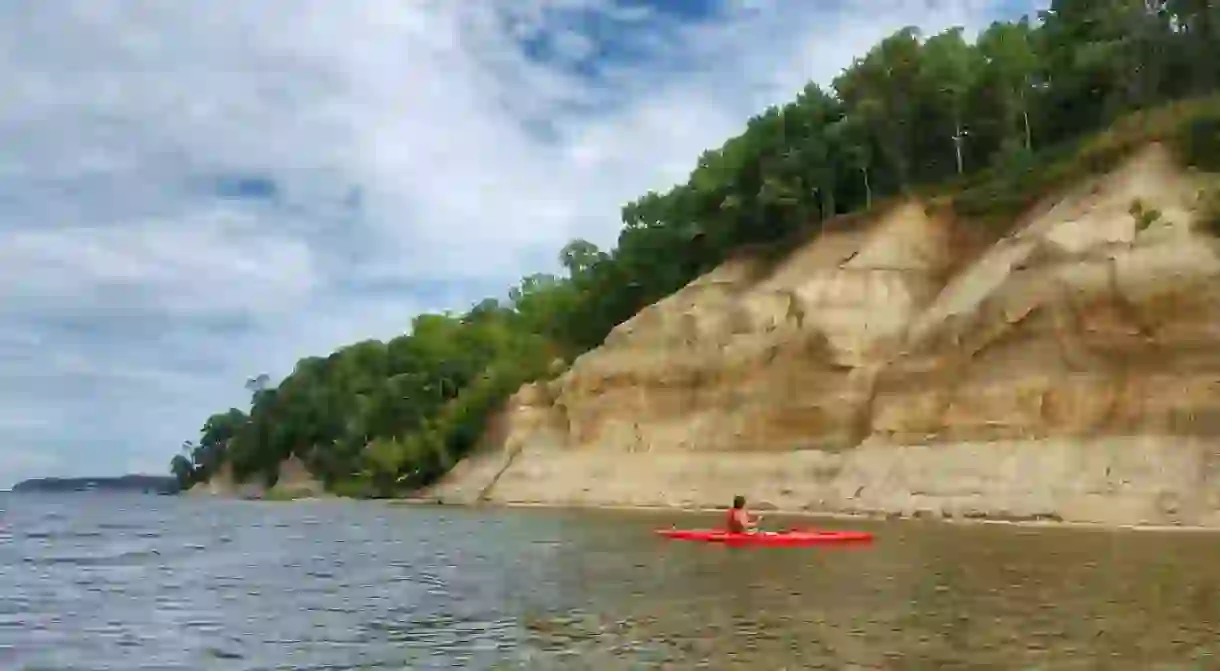How to Paddle the Potomac River

The Potomac River flows from high in the Blue Ridge Mountains, creating the border between West Virginia and Maryland, all the way to the Chesapeake Bay and passing through historic and scenic spots along the way, including Harpers Ferry, Georgetown, and St. Mary’s City. Here’s everything you need to know about paddling the Potomac River, with five spectacular sections to try.
You can, theoretically, kayak the entire length of the Potomac River, a 355-mile (571-kilometer) trip that would take a couple of weeks and involve expert paddling and preparation. Starting just below the man-made Jennings Randolph Lake on the border between West Virginia and Maryland, the river flows all the way to the Chesapeake Bay, and while some areas are rougher than others, the whole river is navigable. A better option is to figure out some of the best day and weekend trips, at some of the most scenic places.
The Paw Paw Bends
On the upper Potomac, the Paw Paw Bends offer a secluded piece of the river to kayak or canoe. Because this section of the river is bordered on the Maryland side by the Green Ridge State Forest, you can explore the river for a day, or make a three-day trip paddling from Town Creek to Little Orleans.
Green Ridge State Forest
Forest, Park

Launch your boat north of Paw Paw (on the West Virginia side of the river), and paddle to the Paw Paw Tunnel campground. At over 3,000 feet (914 meters) long, the tunnel is one of the longest hiking-biking tunnels in the world. There are also a number of campgrounds in the Green Ridge State Forest along the river and pull-offs where you can take a break. At the northern end of the forest (downstream on the Potomac), Little Orleans offers a campground, a restaurant, and a bed and breakfast.
Harpers Ferry
Museum, Natural Feature

A number of outfitters around historic Harpers Ferry, West Virginia, offer kayaking and whitewater rafting along the Potomac and Shenandoah Rivers. River and Trail Outfitters provides your typical whitewater and extreme kayaking, but you can also take a really easy trip down that river that includes stops at breweries and wineries. If you have your own kayak, you can launch it at various spots along the C&O Canal path, a hiking-biking trail that runs on the Maryland side of the Potomac River.
Key Bridge Boathouse
Park

Piscataway Park
Park

Between 1607 and 1609, Captain John Smith (of Disney’s Pocahontas fame, but also a real Englishmen) traveled the Chesapeake and mapped 3,000 miles (4,828 kilometers) of the waterway. Today, a National Historic Trail follows some of the trips that Smith took and showcases early American landscapes and places where indigenous residents used to live. The trail is much bigger than the Potomac River, but at Piscataway Park, where Smith met Piscataway Indians, you can start a lower Potomac adventure. You can launch kayaks at three locations. You don’t have to paddle far to see George Washington’s Mount Vernon home or Fort Washington.
Mallows Bay Park
Park
Mallows Bay Park is a haunting reminder of what can happen to man-made creations. The bay is full of a ghost fleet of WWI steamers that are slowly sinking into the ocean, creating an eerie but beautiful landscape. Paddle around to explore the largest ship graveyard in the Northern Hemisphere. You can launch your own boat from the dock, or rent a boat and schedule a tour with the Atlantic Kayak Company.













